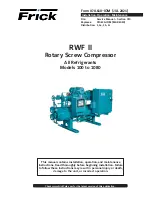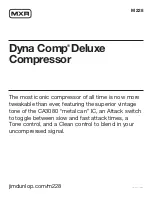
4: Installation
3000PB, 3700B, 4500B, 3000PVB, 3700VB, 4500VB User Manual
02250216-786 R01
48
Subject to EAR, ECCN EAR99 and related export control restrictions.
trap. A drain line should be installed on the condensate
drain.
4.5
Coupling alignment check
No coupling alignment is required.
4.6
Fluid level check
The air compressor is shipped with the proper amount of
fluid installed. However, it is necessary to check the fluid
level at the time of installation and during continued oper-
ation of the compressor. The fluid level is to be checked
when the compressor is in the
SHUT DOWN
mode (fluid
level may not be visible when operating), and by looking
at the sight glass on the separator/sump tank. To be able
to see the fluid level it may be necessary to start the
machine and build the separator/sump tank pressure up
to 10/20 psi and then shut down. Wait a few minutes to
check oil level. If no fluid level is seen in the sight glass
add fluid to the center of the glass. Do not overfill in any
case. When a complete fluid change is performed, fill the
separator/sump tank to the maximum allowable fluid
level, which is center of the sight glass.
4.7
Electrical preparation
Interior electrical wiring is performed at the factory.
Required customer wiring should be done by a qualified
electrician in compliance with OSHA, National Electric
Code and/or any applicable local electrical code concern-
ing isolation switches, fused disconnects, etc. Sullair pro-
vides a wiring diagram for use by the installer. An
electrical check should be made to help assure that the
first start-up will be trouble-free. The compressor and
drive should be properly grounded/earthed in accordance
with Local and National Code requirements.
Installation of this compressor must be in accordance
with recognized electrical codes and any local Health and
Safety Codes.
Feeder cables should be sized by the customer/electrical
contractor to ensure that the circuit is balanced and not
overloaded by other electrical equipment. The length of
wiring from a suitable electrical feed point is critical as
voltage drops may impair the performance of the com-
pressor. Cable sizes may vary considerably so the mains
terminals will accept up to 50 mm2 (1 awg) (37/4 Sk &
50/60 H) and up to 90 mm2 (3/0 awg) (55/75 k & 75/
100 H) cable.
Feeder cable connections to incoming terminals L1-L2-
L3 should be tight and clean.
The applied voltage must be compatible with the motor
and compressor data plate ratings.
A starter hole is provided for incoming power connection.
If it is necessary to make a hole in the control box in a dif-
ferent location, care should be taken to not allow metal
shavings to enter the starter and other electrical compo-
nents within the box. If another hole is used, the original
hole must be blocked off.
1. Check incoming voltage. Be sure that the
incoming voltage is the same voltage that the
compressor was wired for.
2. Check motor starter and overload heater
sizes.
3. Check all electrical connections for tight-
ness.
4. Check the electrical controls by disconnect-
ing the three (3) motor leads from the starter.
Energize the control circuits by pushing the
(Start) pad and check all protective
devices to be sure that they will de-energize
the starter coil when tripped.
5. Reconnect the three (3) motor leads and jog
the motor for a direction of rotation check, as
explained in
4.8
Motor rotation direction check
Motor rotation check must be made at compressor start-
up. The compressor can be damaged if it runs in the
wrong direction for more than a few seconds. Motor rota-
tion can be viewed through the opening in the drive
adapter housing. After the electrical wiring has been
done, it is necessary to check the direction of the motor
rotation. Pull out the
EMERGENCY STOP
button and
press once, quickly and in succession, the
(Start)
NOTE
For low-volume systems that do not require an
auxiliary separator/sump, compressor response
time may need to be adjusted. Consult the Sul-
lair Service Department for assistance.
DANGER
Lethal shock hazard inside. Disconnect all
power at source before opening or servicing.















































